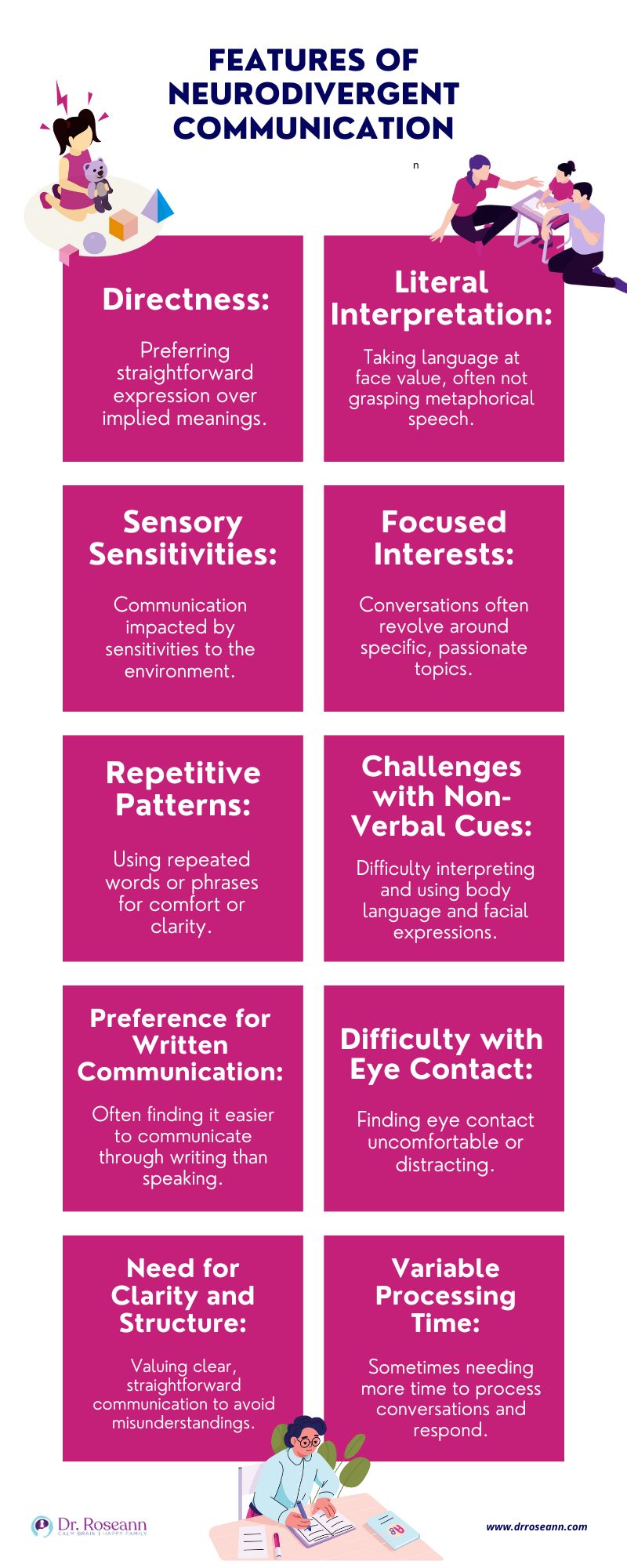Communication acts as a pivotal bridge connecting us, enriched by the diversity inherent in our cognitive processes. This dynamic interplay of dialogue reveals variations between neurotypical individuals and those who are neurodivergent, each contributing their distinct perspectives and styles.
Neurodivergent individuals, in particular, offer valuable insights and expressions derived from their unique ways of perceiving and interacting with the world, thereby enhancing the depth of our conversations.
My professional journey in working with neurodivergent children and teenagers as a therapist and diagnostician has been an enlightening experience in the nuances of communication.
It has underscored the realization that effective communication transcends mere words; it involves a comprehensive embrace and celebration of the many ways through which we experience and share our interpretations of the world around us.
Neurotypical vs. Neurodivergent Communication

Neurotypical (NT) vs neurodivergent (ND) communication can be likened to speaking different languages. While neurotypical communication operates within the framework of societal norms and expectations.
While neurotypical people often rely on implicit social cues and conventional speech patterns, neurodivergent communication may diverge from these established standards. This divergence doesn't denote superiority or inferiority. Rather, it underscores the richness and diversity of human interaction (Hanna Bertilsdotter Rosqvist et al., 2020).
Neurodivergent Communication Styles
In non-neurotypical communication, individuals may express themselves in ways that differ from what is expected. This can manifest in various neurodivergent vs neurotypical communication styles, such as:
Directness vs. Indirectness
Neurotypical communication often involves implicit messages and indirect language. Such people rely on social context and inferred meanings. In contrast, neurodivergent individuals may communicate more directly, stating their thoughts and intentions explicitly without relying on subtle cues.
Sensory Sensitivity Influence
Neurodivergent communication styles may be influenced by sensory sensitivity to the circumstances in which a conversation occurs (Morgan, 2019). For instance, someone with an autism spectrum disorder might prefer clear, literal language due to challenges in processing sensory information, while neurotypical individuals might convey meaning through tone of voice or facial expressions.
Repetitive Patterns
Neurodivergent individuals might exhibit repetitive speech patterns or focus intensely on specific topics of interest. While this behavior might seem unusual from a neurotypical perspective, it serves as a form of self-expression and comfort for the individual.
Literal Interpretation
Neurodivergent people may interpret language more literally than neurotypicals. Metaphors, sarcasm, and figures of speech might be confusing or misunderstood by neurodivergent children.
Sensory Sensitivity
Many neurodivergent people experience sensory sensitivities that can influence their communication. Background noise, bright lights, or certain textures might distract or overwhelm them.

Tips for Parents of Neurodivergent Children
For parents navigating the complex realm of neurodivergent communication, understanding and support are paramount. Implementing tailored strategies can greatly enhance the communication skills and overall well-being of neurodivergents.
1. Educate Yourself
Learn about your child's specific neurodivergence and how it might affect their communication style. Understanding their perspective is crucial for effective communication. Additionally, seek out resources such as books, support groups, and professionals specializing in neurodiversity to deepen your understanding and provide informed support.
2. Be Patient and Flexible
Recognize that communication might look different for your child. Be patient and open to different forms of expression. Remember that progress in communication skills may take time, and celebrating small achievements along the way can foster confidence and motivation in your child's journey.
3. Provide Support
Offer support tailored to your child's needs. This might include therapy, social skills training, or assistive communication devices. Additionally, creating a supportive environment at home and advocating for accommodations in educational settings can greatly enhance your child's communication development and overall well-being.
4. Bridge the Gap
Inclusive communication involves recognizing and accommodating diverse communication styles. Whether neurotypical or neurodivergent, everyone deserves to be understood and respected. Through understanding and acceptance, we can bridge the gap between different communication styles and create a more inclusive society.
Neurodivergent communication enriches our understanding of human interaction. Embracing diversity in communication styles is not only essential for inclusivity but also enriches our collective experience of connection and understanding.
Understanding and appreciating these differences is crucial for fostering inclusive communication environments. Rather than imposing neurotypical standards as the default, embracing non-neurotypical communication styles enriches our collective understanding of other people and promotes acceptance and respect for neurodiversity.
What is neurotypical behavior?
Neurotypical behavior refers to typical patterns of cognition, communication, and social interaction exhibited by the majority of the population. In the context of neurodiversity, people who are neurotypical define themselves as those who display behaviors within expected societal norms without significant deviations.
How do you know if you're neurodivergent?
Recognizing if you belong to neurodivergent adults involves identifying persistent challenges or differences in cognitive processing, social interactions, or sensory experiences that significantly impact daily functioning. Seek professional evaluation to help clarify whether you align with the characteristics of a neurodivergent person.
How to tell if someone is neurodivergent?
Identifying neurodivergent individuals involves recognizing behaviors or traits that deviate from typical neurotypical patterns, such as heightened sensory sensitivity, repetitive behaviors, or difficulties with social interactions. Observing these characteristics can indicate that someone may fall within the spectrum of ND people or non-neurotypical.
What percentage of the population is neurodivergent?
The exact global percentage of neurodivergence in adults and kids is not precisely known, as neurodivergence encompasses a wide spectrum of conditions and traits, including neurodivergent thinking. However, estimates suggest that a significant portion of the population may be neurodivergent.
What is the difference between neurodiverse and neurotypical people?
The difference between being neurodivergent or neurotypical lies in their neurological makeup and associated behaviors. A neurotypical person exhibits typical patterns of cognition and behavior while being neurodivergent entails having variations in neurological development, leading to distinct neurodivergent behaviors and cognitive processes.
What does it mean to be neurotypical?
Being neurotypical refers to having typical patterns of cognitive processing, social interaction, and behavior that align with societal norms, contrasting with the neurodivergent behaviours often observed in neurodiverse people.
How do neurotypicals think?
Neurotypicals typically process information in a linear and socially conventional manner, often relying on implicit social cues and norms for communication and interaction. This cognitive style contrasts with the varied and divergent thinking patterns often observed in our neurodivergent friends, who may approach problems and situations more clearly and creatively.
What is it like to be neurotypical?
To be neurotypical means experiencing typical patterns of cognitive processing and social interaction, which may differ from those in the neurodivergent population. Neurotypical individuals often navigate social situations with ease and adhere to societal norms, contrasting with the experiences of those who are not neurotypical, highlighting the difference between neurotypical and neurodivergent traits.
Are autistic people neurodivergent?
Yes, autistic people are considered neurodivergent as they have a diverse range of neurological characteristics that differ from typical neurotypical traits. Autism is a neurodevelopmental condition characterized by differences in behavior, social communication, and sensory processing, representing one subset of the broader category of neurodivergent individuals, including those in adulthood who exhibit differences between neurotypical and neurodivergent behaviors.
Can you be neurodivergent and not autistic?
Concerning autism vs neurodivergent, it is possible to be neurodivergent without being autistic, as neurodivergence encompasses a broad spectrum of neurological differences beyond autism. While some people with divergent and autism traits may exhibit specific autistic communication styles and autistic tone of voice, their characteristics may vary greatly across various conditions and experiences.
Are ADHD people neurodivergent?
Yes, individuals with ADHD are considered neurodivergent, as ADHD represents a variation in neurological functioning compared to typical neurotypical traits. Characteristics such as ADHD tone of voice and different ADHD neurotypes contribute to the neurodivergent nature of individuals with non-neurotypical ADHD.
Citations
Hanna Bertilsdotter Rosqvist, Chown, N., & Stenning, A. (2020). Neurodiversity Studies: A New Critical Paradigm. Routledge.
Morgan, H. (2019). Connections Between Sensory Sensitivities in Autism; the Importance of Sensory Friendly Environments for Accessibility and Increased Quality of Life for the Neurodivergent Autistic Minority. PSU McNair Scholars Online Journal, 13(1). https://doi.org/10.15760/mcnair.2019.13.1.11
Dr. Roseann is a mental health expert in Neurodivergence who frequently is in the media:
- Evan H. Hirsch, MD – EnergyMD with Dr. Roseann Capanna-Hodge (Video) Topic: Is it Brain Fog or ADHD?
- Parents Are Your Kid's Meltdowns a Sign of Rejection Sensitive Dysphoria?
- Scary Mommy What Is Self-Regulation In Children, And How Can You Help Improve It?
Always remember… “Calm Brain, Happy Family™”
Disclaimer: This article is not intended to give health advice and it is recommended to consult with a physician before beginning any new wellness regime. *The effectiveness of diagnosis and treatment vary by patient and condition. Dr. Roseann Capanna-Hodge, LLC does not guarantee certain results.
Are you looking for SOLUTIONS for your struggling child or teen?
Dr. Roseann and her team are all about science-backed solutions, so you are in the right place!
Grab your complimentary copy of
147 Therapist-Endorsed Self-Regulation Strategies for Children: A Practical Guide for Parents
Dr. Roseann is a Children’s Mental Health Expert and Licensed Therapist who has been featured in/on hundreds of media outlets including The Mel Robbins Show, CBS, NBC, PIX11 NYC, Today, FORBES, CNN, The New York Times, The Washington Post, Business Insider, Women’s Day, Healthline, CNET, Parade Magazine and PARENTS. FORBES called her, “A thought leader in children’s mental health.”

She coined the terms, “Re-entry panic syndrome” and “eco-anxiety” and is a frequent contributor to media on mental health.
Dr. Roseann Capanna-Hodge has three decades of experience in working with children, teens and their families with attention-deficit hyperactivity disorder (ADHD), autism, concussion, dyslexia and learning disability, anxiety, Obsessive Compulsive Disorder (OCD), depression and mood disorder, Lyme Disease, and PANS/PANDAS using science-backed natural mental health solutions such as supplements, magnesium, nutrition, QEEG Brain maps, neurofeedback, PEMF, psychotherapy and other non-medication approaches.
She is the author of three bestselling books, It’s Gonna Be OK!: Proven Ways to Improve Your Child's Mental Health, The Teletherapy Toolkit, and Brain Under Attack. Dr. Roseann is known for offering a message of hope through science-endorsed methods that promote a calm brain.
Her trademarked BrainBehaviorResetⓇ Program and It’s Gonna be OK!Ⓡ Podcast has been a cornerstone for thousands of parents facing mental health, behavioral or neurodevelopmental challenges.
She is the founder and director of The Global Institute of Children’s Mental Health, Neurotastic™Brain Formulas and Dr. Roseann Capanna-Hodge, LLC. Dr. Roseann is a Board Certified Neurofeedback (BCN) Practitioner, a Board Member of the Northeast Region Biofeedback Society (NRBS), Certified Integrative Mental Health Professional (CIMHP) and an Amen Clinic Certified Brain Health Coach. She is also a member of The International Lyme Disease and Associated Disease Society (ILADS), The American Psychological Association (APA), Anxiety and Depression Association of America (ADAA) National Association of School Psychologists (NASP), International OCD Foundation (IOCDF).
© Roseann-Capanna-Hodge, LLC 2024










